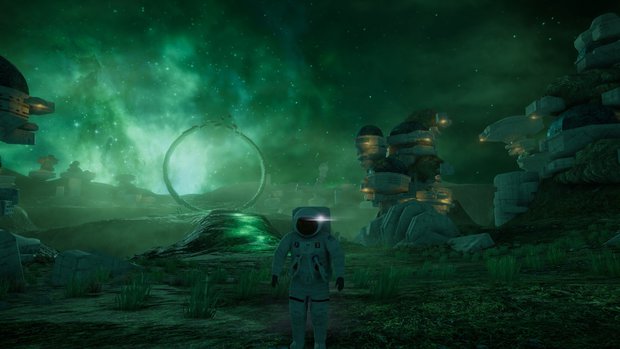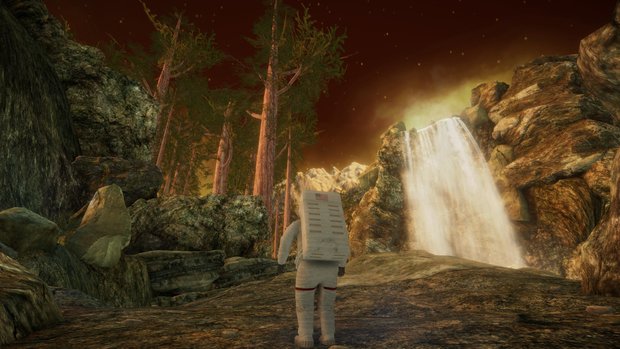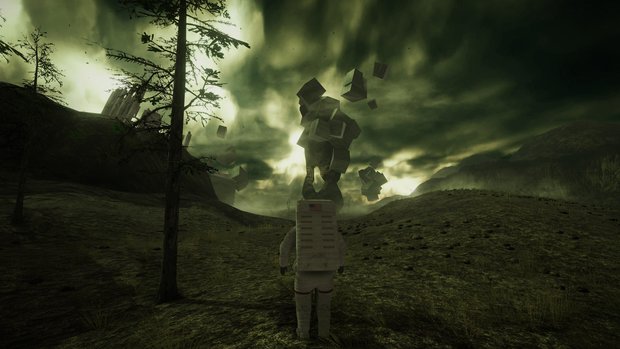Lifeless Moon review

- 1 Comment
Heavy on the sci-fi, light on gravity and challenge but exploration largely sticks the landing
NASA’s Apollo Program has spawned myriad fictional books, films, and of course video games over the years. Stage 2 Studios’ third-person adventure Lifeless Moon continues this tradition by thrusting players straight into a situation that is both compelling and hair-raising: you are an Apollo-era astronaut exploring the moon, and you get separated from your crewmate. You press forward, accompanied only by hallucinatory visions of your missing companion, until you spot a seemingly impossible sight in the distance: a small town, standing mostly intact on the airless, desolate lunar surface.
Although it is the spiritual successor to 2014’s Lifeless Planet, and gameplay will be very familiar to veterans of that game, Lifeless Moon mostly treads its own ground, with new themes, characters, and environments. The plot once again harks back to the Golden Age of Science Fiction, though it can be a bit too ambitious for its own good at times. What returning players will likely wonder most about, however, is what happened to the puzzles? Unfortunately, there isn’t a lot of challenge here. However, if you are up for some heady exposition, brisk exploration, and gorgeous graphics, Lifeless Moon has all that in spades across its 4-5 hours of playtime.
Lifeless Moon may look a lot like an action-adventure game, but in practice the exploration-heavy gameplay borders on being a walking simulator, with most of the player’s time spent poking around the various locales for a point of interest (e.g., interesting fossils or a vehicle) or item (such as a key or photograph) that advances the story or opens up another area for further investigation. The keyboard and mouse controls are fairly standard, with mappings for running, jumping, and hotkeys for features like the notebook and inventory. The mouse is mainly used for panning the camera. Gamepads are also supported, and using one is just as intuitive as the mouse and keyboard.

The only real exception is the platform-jumping mechanic, and a jetpack that comes into use later in the game. However, aside from the occasional fall due to a timing misjudgment or by completely discharging your jetpack (which instantly recharges when not in use) before reaching the intended landing spot, these segments will likely be easy for anyone to overcome, even those working around dexterity issues. From what I can tell, you cannot die from falling (or anything else, for that matter), so the only penalty is having to trek your way back to the place where you fell.
The vast majority of your time will be spent viewing your character in third-person perspective, yet a few puzzle sequences switch the game into first-person mode. I suspect the reason for this change is a practical one, given that the camera’s considerable default trailing distance behind the protagonist simply wouldn’t fit comfortably within the indoor spaces these segments take place in. However, the sense of immediacy gained from the perspective change is interesting, and the hotspot-based point-and-click navigation for these sequences is a welcome homage to more traditional adventure games.
The story of Lifeless Moon is an ambitious one. Although your astronaut is unnamed, you come to discover that you and your crewmate are not the only ones involved here. Before you, a team of scientists studying antimatter physics discovered a way to teleport across time and space, and you follow along in their footsteps as you uncover the truth: that we are not alone in the universe, and the scientists found a way to harness an immense ability to shape reality that the mysterious lifeforms they encountered possess.

The personalities of the five scientists involved are revealed through their writings and occasionally even brief interactions when the story calls for it. With much of the plot told through (voiced) letters, this technique requires close attention from the player but rewards those willing to piece everything together with a tale of grief, loss, and the promise and danger of the unknown. It’s not the most original narrative ever devised, but the search for the scientists and what happened to them after their profound discovery kept me engaged. For instance, they speak of personal illnesses occurring just by thinking about them, yet seemingly clearing up the same way. One character, succumbing to a mysterious mental illness, cruelly taunts his fellow scientists with his abilities.
I will admit, however, that it was hard to follow the story at times, an issue that seems to stem from the same thing that makes it intriguing: the letters and writings that provide only a fragmentary, nonlinear account of events prior to your arrival. The ambitiousness of the themes in play, and a seeming desire to include as many kinds of environments as possible to explore, also detract somewhat from the narrative comprehensibility and render the other characters little more than vehicles for the ideas the game revolves around. It’s possible this was deliberate: in their writings the characters refer to each other almost exclusively by their job titles, such as technician and engineer, although they do have names. By the end, though, most of the plot made sense and I was left with a feeling of awe at what had transpired.
Supposedly there are elements that tie Lifeless Moon to its predecessor, but it has been years since I played Lifeless Planet and I could not pinpoint any direct connections myself. If nothing else, the subtlety of any callbacks ensures that players need not have knowledge of the previous game to enjoy this one.

The in-game notebook documents current and completed objectives, allows you to review prior verbal exposition or letters that were left by the various characters, and even to read a transcript of the player character’s own observations. Some points of interest, such as intriguing geological formations, are optional discoveries that help to flesh out the gameworld and provide a reason to spend more time in areas that would otherwise be run straight past. But the linear progression and obvious environmental fencing such as walls and canyons keeps you from straying too far from your next goal.
For the most part, collected objects like keys are used automatically where appropriate, but there are exceptions. For a certain type of item, you must pick them up and carry them to the location where they will be used. The inventory system, meanwhile, is limited to holding a series of photographs that are significant at various points along the way. As complicated as it may sound, it actually works flawlessly, with no confusion as to what you need to do to use the various things you acquire.
In terms of puzzles, however, the lack of depth is perhaps the most disappointing aspect of Lifeless Moon. The few logic puzzles that appear, such as one involving reflecting light from an unconventional power source to clear an obstacle, or navigating a simple maze in order to lead another entity to an objective, are likewise obvious in both purpose and solution. One recurring inventory puzzle, in which you have to use the photographs to activate an alien device, was probably the most difficult obstacle I encountered, mainly due to its unintuitive control scheme. However, even this was not especially difficult to manage once the trick was understood.
Locales to explore are surprisingly diverse, comprising much more than the moon’s surface, such as a calm meadow with a lakehouse, and a cityscape whose buildings happen to be suspended in midair (did I mention you get a jetpack at one point?), among others. Some are quite lush and serene, while others are more alien, desolate, and unsettling. However, all of them are interesting and complement the game’s focus on exploration.
Bolstering the environments are the 3D graphics, which are absolutely gorgeous. Colors pop off the screen, surreal giant hornet nests glow among a placid forest, and alien technology towers over the protagonist. Indie games must often sacrifice visual fidelity on the altar of budgetary concerns, but Lifeless Moon manages to transcend this problem almost entirely. It was a joy to explore such surroundings, and the developers deserve kudos for their efforts, successfully pulling off a gorgeous photorealistic visual style. One oddity that initially caught my attention is that the depiction of lower gravity, while being a fairly accurate representation for the moon, didn’t seem to change much, if at all, when in non-lunar environments. Whether anyone except space buffs will notice or care about this is an open question, but it is a notable apparent oversight of the science part of this science fiction adventure.
The music is likewise fitting for a sci-fi story like Lifeless Moon. The orchestral-meets-synth soundtrack feels appropriately grand yet futuristic. A variety of tempi and sonic textures accompany the action, with tension, excitement, and even an air of mystery, to name a few emotions conveyed throughout the game. Sound effects are also well done, although nothing overly remarkable, ranging from footsteps, animal sounds, and the rustling of pages to loud explosions.
Final Verdict
All in all, Lifeless Moon is a worthy successor to Lifeless Planet. Puzzle lovers should look elsewhere for a challenge, but the focus on exploration and the classic sci-fi plot will likely draw in those looking for a few hours’ immersion in an intriguing world of scientific mishaps and alien influence. The exposition-heavy narrative certainly delivers interest and will likely keep players motivated to learn more, even if tracing the story through written documents occasionally becomes difficult to follow. And all throughout, the lush graphics are top-notch for an indie game, and will likely inspire a few “wows” along the way. The lesser challenge makes it perhaps a small step back from its spiritual predecessor, but if Stage 2 Studios decides to breathe life into a trilogy of Lifeless games, I’ll gladly go wherever they lead.
Hot take
Toning down the puzzles this time around wasn’t the best idea, but otherwise Lifeless Moon delivers more of what made its predecessor enjoyable for the most part, gorgeously presenting its well-told story of a scientific experiment gone wrong, and the peril and promise of the unknown.
Pros
- Intriguing plot reminiscent of the Golden Age of science fiction, dealing with themes of grief, loss, and the unknown
- Environments are varied and gorgeous
- Soundtrack is enjoyably cinematic
Cons
- Puzzles are far too easy
- Reliance on writings to tell the story can be confusing at times
Kacey played Lifeless Moon on PC using a review code provided by the game's publisher.









1 Comment
Want to join the discussion? Leave a comment as guest, sign in or register.
"Puzzles are far too easy" There were puzzles? If by puzzles you mean "walk vast distances while touching everything in the hopes something finally happens." I found them to be hard, aggravating, and boarding on obnoxious. If I had played this first I wouldn't have played Lifeless Planet, and would have missed out on a fun little game.
Reply
Leave a comment